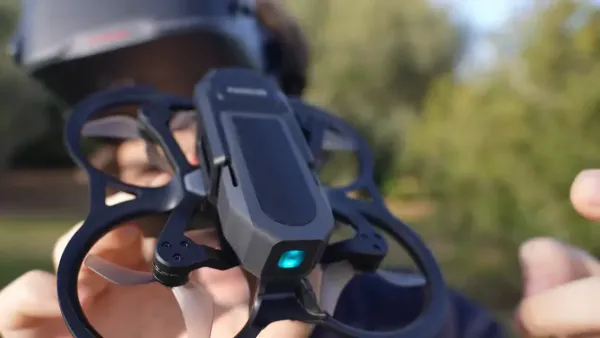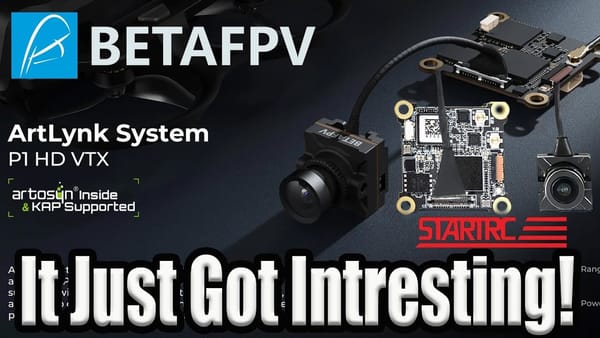FPV drones have a dizzying array of digital video transmission systems. From DJI's in-house Ocusync to Wi-Fi-based hacks, the landscape is confusing. Understanding the technical guts behind these systems explains why some dominate the skies while others sputter behind.
TL;DR
- FPV digital systems split into Wi-Fi derivatives and fully custom SDRs.
- Wi-Fi systems use fixed-function chipsets with limited control, affecting range and latency.
- DJI Ocusync is a fully custom in-house SDR system with proprietary chipsets and software.
- Caddx Avatar HD uses Artisan chipsets with a WiMAX heritage, not a DJI clone.
- HDZero employs a mysterious joint source channel coding method, achieving ultra-low latency.
FPV Digital Systems: Wi-Fi vs Custom
Digital FPV systems fall into two camps: Wi-Fi and Wi-Fi-derived setups, and custom systems. The former either use standard Wi-Fi protocols or modify Wi-Fi hardware with custom drivers. The latter employ fully bespoke software and hardware, often using software-defined radios (SDRs).
Some products straddle these categories. The DJI Neo, for instance, uses Ocusync with DJI's proprietary remote but switches to standard Wi-Fi when controlled via smartphone.

Wi-Fi Full Spec vs Wi-Fi Derived
Full Wi-Fi systems conform exactly to the 802.11 standard. The DJI Neo smartphone connection is a prime example—it sets up an ad hoc hotspot visible to any Wi-Fi device, allowing easy connection. However, this comes with the classic Wi-Fi downsides: limited range and interference sensitivity.
Wi-Fi-derived systems use the same hardware but replace standard drivers with custom ones at the MAC layer. This lets them bypass normal Wi-Fi protocols but still confines them to the fixed-function hardware’s capabilities. They are invisible to typical Wi-Fi scanners and tools like Wireshark.

Hardware Constraints
These Wi-Fi chipsets have a fixed physical (PHY) layer baked into silicon. Parameters like frequency bands, channel allocation, and waveform generation are non-negotiable. Custom drivers can only tweak the data sent through this “pipe,” not the pipe itself.
Think of the hardware as a fixed-diameter pipeline. You can change the contents flowing through it, but you can't widen the pipe or change its material.
Wi-Fi Derived Systems: Bare Metal Mode
Projects like OpenIPC, RubyFPV, and Edge T3 use a “bare metal mode” to take more control over the Wi-Fi hardware's RF link. They bypass many standard Wi-Fi features such as packet acknowledgments and error correction schemes, allowing more flexibility in data transmission.
OpenIPC uses WFBNG software for RF encoding, while RubyFPV has its own encoding derived from older forks. Edge T3 appears to do basic IP streaming without complex encoding or error correction.
Despite these hacks, Wi-Fi hardware limitations remain. These systems can’t generate custom waveforms outside the 802.11 standard, capping performance and range compared to true SDRs.
HDZero: The Black Box of FPV
HDZero stands apart with its use of joint source channel coding (JSCC), a technique that merges image compression and wireless encoding into one step. While this approach is rare and poorly documented, it promises lower latency and reduced distortion.
This technology traces back to the long-defunct Amimon ProSight HD system. HDZero uses custom ASICs developed in-house by DiviMath, with no off-the-shelf hardware besides the MIPI interface and power amplifiers.

HDZero is a one-way streaming link, not bidirectional. It delivers digital video with analog-like breakup and sparkles, giving it a unique hybrid digital-analog feel. The system's low latency—down to 1ms for first pixel—is unmatched by competitors but remains a bit of a mystery.
DJI Ocusync: The In-House SDR King
DJI’s Ocusync is a fully custom SDR system developed entirely in-house. It evolved from Wi-Fi and Lightbridge (based on WiMAX and Artisan chipsets) to a proprietary LTE-modem-based SDR using the Ledcore chipset, then onto DJI’s own P1 and S1 chipsets.
The P1 chipset, introduced with DJI’s original digital FPV system, integrates ARM cores for Linux, a CEVA DSP for RF baseband processing, and a custom RF front end. It generates fully custom waveforms beyond Wi-Fi’s limitations and runs DJI’s entire software stack.

DJI later offloaded video encoding and OS tasks to the E3T chipset, leaving the P1 as a modem. The E3T offers better video encoding, decoding, and vision processing, boosting image quality and DVR capabilities.
O4 upgrades the modem again with the S2 chipset, increasing bandwidth to 80 MHz and supporting up to six antennas. The E3T remains for video processing. This modular approach allows DJI to evolve hardware components independently.

DJI and Artisan: Parallel Paths
DJI previously collaborated with Artisan for Lightbridge, which was based on WiMAX technology. However, Ocusync is a clean break, with no proven link to Artisan chipsets. Artisan’s hardware and software heritage continue in Caddx Avatar HD instead.
Caddx Avatar HD: The Artisan Off-the-Shelf SDR
Caddx’s Avatar HD system uses Artisan’s AR9201 chipset, a full SDR with WiMAX roots. It runs Linux on ARM cores and employs a CEVA DSP focused on image processing, unlike DJI’s RF-centric DSP.
Though similar in architecture to DJI’s P1, Avatar HD is not a clone. It inherits Artisan’s WiMAX lineage and uses the Artisan SDK with Caddx’s UI on top, rather than a fully custom software stack.
This off-the-shelf approach limits flexibility compared to DJI’s vertically integrated system but still delivers good performance. The chipset supports up to two transmit and four receive antennas, making it competitive, though not quite at DJI’s level.
Why DJI Still Reigns
DJI’s complete control of hardware and software lets them fine-tune every element, from RF waveforms to video processing. Off-the-shelf solutions like Artisan-based Avatar HD or Wi-Fi-derived systems cannot match this level of optimisation.
Wi-Fi-based systems are shackled by fixed hardware limits, poor range, and latency. Even Artisan’s SDRs, while flexible, carry WiMAX baggage and lack DJI’s polish.
HDZero’s unique JSCC offers ultra-low latency but lacks bidirectional communication and remains niche.
Conclusion
The digital FPV space divides into constrained Wi-Fi derivatives, Artisan-based SDRs, and fully custom systems like DJI’s Ocusync. DJI’s in-house chipsets and software deliver the best range, image quality, and link resilience.
Caddx Avatar HD offers a capable SDR alternative rooted in Artisan’s WiMAX heritage, while HDZero pursues a radically different low-latency approach.
Wi-Fi systems, though accessible, cannot compete on performance and are unlikely to ever match bespoke SDR solutions.
FAQs
- What are the main categories of digital FPV systems?
They split into Wi-Fi and Wi-Fi-derived systems using fixed hardware, and custom systems using SDRs with bespoke software and hardware. - Is Caddx Avatar HD a copy of DJI’s Ocusync?
No. Avatar HD uses Artisan chipsets with a WiMAX heritage and a different DSP architecture. - Why are Wi-Fi-based FPV systems limited?
Their fixed-function hardware restricts waveform customization, leading to poor range and higher latency. - What makes HDZero unique?
It uses joint source channel coding, combining image compression and wireless encoding to reduce latency dramatically. - What is DJI’s Ocusync?
A fully custom in-house SDR system with proprietary chipsets and software controlling the entire wireless video link.
Takeaways
- Wi-Fi FPV systems are constrained by fixed hardware; expect limited range and latency.
- DJI’s Ocusync is a fully custom SDR, controlling hardware and software end-to-end for superior performance.
- Caddx Avatar HD runs on Artisan chipsets with WiMAX roots, not a DJI clone.
- HDZero’s joint source channel coding delivers ultra-low latency but is a one-way link.
- Off-the-shelf solutions can’t match bespoke SDR systems in FPV video quality and link resilience.
This article was based from the video DJI O4 - Caddx Avatar - HDZero - OpenIPC-Ruby- Edge T3 - Digital FPV Technical Differences & History







